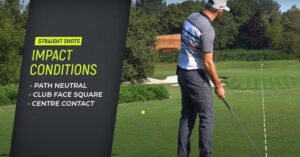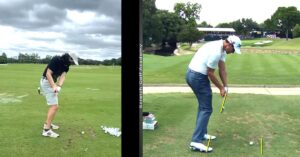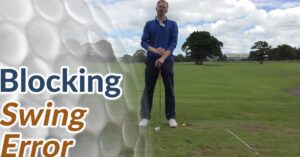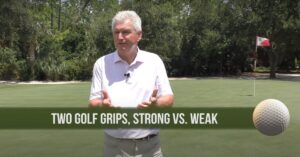What Is A Block In Golf: Analyzing Causes And Fixes
Golf is a challenging sport that requires skill and practice to master. One of the shots that golfers commonly encounter is the block. If you’re new to golf, you may be wondering what a block is and how to fix it.
A block in golf is a shot that travels straight to the right (for a right-handed golfer) of the intended target. It’s caused by the clubface being open at impact, which means it’s pointing to the right of the target. To fix a block, golfers can adjust their grip, alignment, and swing path to ensure the clubface is square at impact.
In the following section of this post, we’ll provide a comprehensive guide to help you understand what a block is, what causes it, and how to fix it.
Causes Of A Block In Golf
Mastering the causes of a block can help golfers identify and correct this issue to improve their overall game.
Here, we will explore some common factors that contribute to a block in golf and discuss potential solutions.
Improper Alignment
Alignment plays a crucial role in hitting accurate shots in golf. If your body and clubface are not properly aligned with the target, it can lead to a block.
When your body is open to the target line, meaning your shoulders, hips, and feet are pointing to the left (for right-handed golfers), the clubface tends to follow suit.
This alignment can result in an outside-to-in swing path, causing the ball to block to the right.
Weak Grip
The way you hold the club, known as your grip, significantly influences the direction and flight of your shots.
A weak grip, where your hands are turned too far to the left (for right-handed golfers), can cause a block.
It encourages an open clubface at impact, resulting in the ball flying to the right.
Swing Path
The swing path refers to the direction the clubhead travels during the golf swing. An outside-to-in swing path is a common cause of a block.
When the club approaches the ball from the outside and crosses the target line through impact, it promotes a block shot.
Weight Distribution
Proper weight distribution is vital for a balanced and effective golf swing. If your weight is distributed too much on the toes or heels during the swing, it can affect your ability to make solid contact with the ball and cause blocks.
Ideally, your weight should be evenly distributed between your feet at address and shift smoothly from back foot to front foot during the swing.
Techniques To Correct A Block In Golf
Golf can be a frustrating game, especially when you find yourself consistently hitting shots that veer off to the right (for right-handed golfers).
This common mistake, known as a block, can be corrected with the right techniques and adjustments.
Identify the Cause
The first step in correcting a block in golf is to identify the root cause of the issue.
Several factors can contribute to this problem, such as poor alignment, an open clubface at impact, or an incorrect swing path.
Take the time to assess your swing and analyze your ball flight to pinpoint the specific cause.
Adjust Your Alignment
Improper alignment is often a primary cause of blocked shots. To correct this, start by aiming slightly left of your target (for right-handed golfers).
This adjustment will help compensate for any potential push or block, ensuring your shots find the intended target.
Check Your Grip
Another crucial aspect to consider is your grip. A weak grip, where your hands are rotated too far to the left (for right-handed golfers), can lead to an open clubface at impact and result in a block.
Ensure that your grip is neutral or slightly stronger, allowing for better clubface control.
Focus on Your Swing Path
The swing path plays a significant role in the direction of your shots. A common mistake that causes blocks is an out-to-in swing path, where the club approaches the ball from outside the target line.
To correct this, work on swinging along an inside-to-square-to-inside path, promoting a more accurate and straighter shot.
Maintain Proper Body Rotation
Proper body rotation is crucial for a consistent golf swing. A lack of rotation or an overactive upper body can contribute to blocks.
Focus on initiating the downswing with your lower body, allowing your hips to lead the way.
This action will help you create a more on-plane swing and reduce the chances of blocking the ball.
Practice Tempo and Timing
Achieving the right tempo and timing in your swing is vital to hitting straight shots. Rushing your swing or losing control of your tempo can lead to poor shot direction, including blocks.
Work on maintaining a smooth and controlled swing, focusing on the rhythm and timing of your movements.
Tips For Preventing Blocks In Your Golf
These blocks can be frustrating and hinder progress. However, there are several strategies you can employ to prevent and overcome blocks in your golf game.
By incorporating these tips into your practice routine and mindset, you can maintain a steady performance and improve your overall game.
Maintain a Positive Mindset
A positive mindset is crucial in preventing blocks in your golf game. Avoid dwelling on mistakes or getting caught up in negative thoughts.
Instead, focus on the present moment, stay confident, and visualize successful shots. Cultivate a belief in your abilities and trust your swing.
Practice Mental Imagery
Visualization can be a powerful tool in golf. Spend time mentally rehearsing successful shots and visualize yourself executing them flawlessly.
This technique can help improve your muscle memory and build confidence, reducing the likelihood of experiencing blocks during a round.
Develop a Consistent Pre-Shot Routine
Establishing a consistent pre-shot routine can provide stability and focus during your rounds. This routine can help calm your nerves and create a sense of familiarity, reducing the chances of experiencing blocks.
Tailor your routine to fit your game, but ensure it includes elements like alignment, visualization, and a specific trigger to initiate your swing.
Work on Your Physical Conditioning
Physical fitness plays a significant role in preventing blocks in golf. Engage in regular exercise to improve your strength, flexibility, and stamina. Incorporate golf-specific exercises that target core strength and rotational movements.
A strong and conditioned body can enhance your swing mechanics and reduce the risk of physical fatigue-induced blocks.
Analyze and Adjust Your Technique
If you consistently face blocks in your game, consider seeking professional guidance to analyze your swing technique.
A golf instructor or coach can identify any flaws or inconsistencies and provide corrective measures.
Regular practice and adjustments based on expert advice can help you develop a more reliable and consistent swing, reducing the occurrence of blocks.
Focus on Course Management
Developing effective course management skills can help prevent blocks and maintain steady performance.
Assess the course layout, make smart decisions regarding shot selection, and play within your abilities.
Avoid taking unnecessary risks that can lead to mistakes and frustration.
Instead, adopt a strategic approach that maximizes your strengths and minimizes the chances of encountering blocks.
Embrace Patience and Persistence
Golf is a challenging sport that requires patience and persistence. Recognize that blocks are a normal part of the learning process and view them as opportunities for growth.
Stay committed to your practice routine and maintain a positive attitude even when faced with setbacks. Consistency and perseverance will help you overcome blocks and improve your game in the long run.
Frequently Asked Questions
Block shot typically happens when the clubface is open at impact, causing the ball to travel in an unintended direction.
To help you understand this golfing term better, here are some FAQs explained in a quick and clear manner:
How Can I Fix A Block In Golf?
To fix a block in golf, focus on aligning the clubface properly at the address and throughout the swing. Practice squaring the clubface at impact, and ensure your body rotation and weight transfer are in sync. Working with a golf instructor can provide personalized guidance to correct a block.
Is A Block Different From A Slice In Golf?
Yes, a block and a slice are different types of shots in golf. A block starts relatively straight before curving away, while a slice starts to the left (for right-handed players) or to the right (for left-handed players) and curves even more severely in that direction.
How Can I Prevent Blocks In Golf?
To prevent blocks in golf, focus on proper alignment, grip, and swing mechanics. Practice keeping the clubface square to the target line at impact. Work on maintaining a balanced swing and consistent ball position. Regular practice and feedback from a golf professional can help you improve and reduce blocks.
Conclusion
A block is a common shot in golf that can be frustrating for golfers. However, by understanding the causes of a block and how to fix it, golfers can improve their game and avoid this shot.
With practice and patience, golfers can learn to hit straighter shots and enjoy the game even more.






